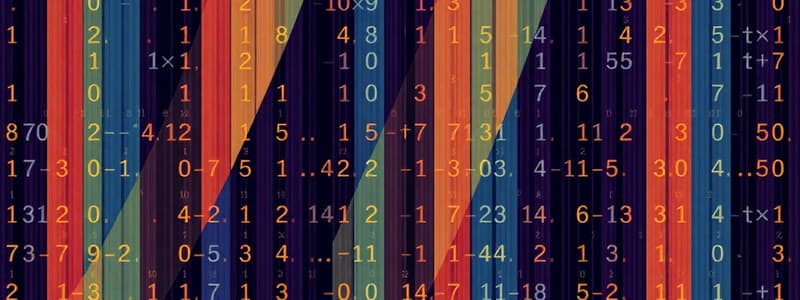Podcast
Questions and Answers
What is the main advantage of using an algorithm in problem-solving?
What is the main advantage of using an algorithm in problem-solving?
- They break down complex tasks into manageable steps. (correct)
- They provide a flexible approach to any problem.
- They require extensive human intervention.
- They complicate complex tasks.
What characteristic of algorithms is crucial for applications managing large amounts of data?
What characteristic of algorithms is crucial for applications managing large amounts of data?
- Comprehensibility
- Simplicity
- Efficiency (correct)
- Universality
What type of algorithm is used for finding the greatest common divisor (GCD) of two integers?
What type of algorithm is used for finding the greatest common divisor (GCD) of two integers?
- Dijkstra’s Algorithm
- Machine Learning Algorithm
- Binary Search Algorithm
- Euclidean Algorithm (correct)
Which of the following best describes Dijkstra’s Algorithm?
Which of the following best describes Dijkstra’s Algorithm?
Why are algorithms considered the foundation of computing?
Why are algorithms considered the foundation of computing?
Which of the following is NOT a benefit of algorithms?
Which of the following is NOT a benefit of algorithms?
In the context of algorithms, what does reusability signify?
In the context of algorithms, what does reusability signify?
What is the process of the Binary Search algorithm primarily based on?
What is the process of the Binary Search algorithm primarily based on?
What is the primary purpose of cryptographic algorithms?
What is the primary purpose of cryptographic algorithms?
How do routing algorithms enhance networking?
How do routing algorithms enhance networking?
Which method is NOT a technique used in algorithm design?
Which method is NOT a technique used in algorithm design?
In which domains are optimization algorithms commonly applied?
In which domains are optimization algorithms commonly applied?
What is a core characteristic of greedy algorithms?
What is a core characteristic of greedy algorithms?
What is the best-case time complexity for Quick Sort?
What is the best-case time complexity for Quick Sort?
What role do recommendation algorithms play in user experience?
What role do recommendation algorithms play in user experience?
What is the first step in the design of algorithms?
What is the first step in the design of algorithms?
What does average-case time complexity represent?
What does average-case time complexity represent?
What is the worst-case time complexity of Insertion Sort?
What is the worst-case time complexity of Insertion Sort?
Which of the following statements is true regarding dynamic programming?
Which of the following statements is true regarding dynamic programming?
What does amortized analysis evaluate?
What does amortized analysis evaluate?
What is the time complexity of a linear search in the worst case?
What is the time complexity of a linear search in the worst case?
Which of the following is true for Binary Search?
Which of the following is true for Binary Search?
What defines a correct algorithm?
What defines a correct algorithm?
What is the average-case time complexity for Merge Sort?
What is the average-case time complexity for Merge Sort?
What is the purpose of benchmarking algorithms?
What is the purpose of benchmarking algorithms?
Which characteristic of an algorithm ensures that it eventually terminates?
Which characteristic of an algorithm ensures that it eventually terminates?
What is a necessary component that algorithms require before execution?
What is a necessary component that algorithms require before execution?
Which of the following statements about effectiveness in algorithms is true?
Which of the following statements about effectiveness in algorithms is true?
Which algorithm is designed specifically to sort items?
Which algorithm is designed specifically to sort items?
What does O(1) represent in terms of time complexity?
What does O(1) represent in terms of time complexity?
What characteristic ensures that each instruction in an algorithm is clear and unambiguous?
What characteristic ensures that each instruction in an algorithm is clear and unambiguous?
Which of the following is an example of quadratic time complexity?
Which of the following is an example of quadratic time complexity?
Which of the following best describes the outputs of an algorithm?
Which of the following best describes the outputs of an algorithm?
What might classify an algorithm as incorrect?
What might classify an algorithm as incorrect?
Which operation is typically analyzed to determine time complexity?
Which operation is typically analyzed to determine time complexity?
What type of time complexity does the Merge Sort algorithm exhibit?
What type of time complexity does the Merge Sort algorithm exhibit?
In big-O notation, why do we focus on the dominant term?
In big-O notation, why do we focus on the dominant term?
Which time complexity indicates the running time grows factorially with input size?
Which time complexity indicates the running time grows factorially with input size?
What does O(log n) time complexity typically represent?
What does O(log n) time complexity typically represent?
What type of algorithms generally exhibit O(n log n) time complexity?
What type of algorithms generally exhibit O(n log n) time complexity?
Flashcards are hidden until you start studying
Study Notes
Algorithm Definition and Characteristics
- An algorithm is a step-by-step procedure to solve a problem or achieve a specific outcome.
- A correct algorithm halts with the correct output for every input; incorrect algorithms may not halt or produce incorrect outputs, but can still be useful if error rates are controllable.
- Key characteristics of an algorithm include definiteness (clear, unambiguous steps), finiteness (finite number of steps), input (initial data), output (result), and effectiveness (easily performed steps).
Algorithm Examples
- Sorting algorithms: Arrange items in order (e.g., Bubble Sort).
- Search algorithms: Find specific items (e.g., Binary Search).
- Mathematical algorithms: Perform mathematical operations (e.g., Euclidean Algorithm for GCD).
- Graph algorithms: Operate on graph structures (e.g., Dijkstra's Algorithm for shortest paths).
- Machine learning algorithms: Build predictive models (e.g., Decision Trees, Neural Networks).
Importance of Algorithms
- Problem-solving: Provide structured approaches to solving problems.
- Efficiency: Reduce time and resources needed for tasks.
- Reusability: Can be reused across different programs and systems.
- Foundation of computing: Essential to software development and computer systems.
Algorithms in Computing
- Algorithms are fundamental to nearly all computer systems and software.
- They handle data, perform operations, and automate tasks involving reasoning.
- Cryptographic algorithms ensure data security (secrecy, authenticity, integrity).
- Routing algorithms optimize data transmission in networks.
- Recommendation algorithms personalize user experiences.
Algorithm Design and Analysis
- Algorithm design: Involves problem definition (understanding requirements and breaking down the problem), and using techniques like divide and conquer, dynamic programming, and greedy algorithms.
- Algorithm analysis: Evaluates algorithm efficiency.
Time Complexity Analysis
- Big O notation: Expresses the growth rate of an algorithm's running time as input size increases.
- Common time complexities: O(1) (constant), O(log n) (logarithmic), O(n) (linear), O(n log n) (linearithmic), O(n²) (quadratic), O(n³) (cubic), O(2ⁿ) (exponential), O(n!) (factorial).
- Analysis types: Best-case, average-case, and worst-case time complexities consider the most and least favorable input conditions and the expected running time, respectively.
- Amortized analysis: Evaluates average time per operation over a sequence of operations.
- Empirical analysis: Uses profiling and benchmarking to measure and compare algorithm performance in practice.
Example Algorithm Analyses
- Linear search: O(n) time complexity (worst case).
- Binary search: O(log n) time complexity.
- Merge sort: O(n log n) time complexity.
Studying That Suits You
Use AI to generate personalized quizzes and flashcards to suit your learning preferences.




